项目管理作业讲解-精品文档
- 格式:ppt
- 大小:388.00 KB
- 文档页数:55
![PDCA循环在项目质量管理中的应用[精品资料]](https://uimg.taocdn.com/89cf8d380166f5335a8102d276a20029bd64637f.webp)
PDCA循环在项目质量管理中的应用-精品资料本文档格式为WORD,感谢你的阅读。
最新最全的学术论文期刊文献年终总结年终报告工作总结个人总结述职报告实习报告单位总结摘要:随着市场经济的发展,建筑业也迅速发展,在这过程中,施工项目质量管理显得相当重要。
工程质量不仅关系到工程适用性和项目成本效果,而且关系到人民群众生命财产安全。
作为施工单位,工程质量的好坏,将直接影响着企业的发展。
本文通过对目前施工项目质量管理方面存在问题的分析,论述了PDCA循环、项目质量管理等理论知识,结合实际工程项目案例,采用理论联系实际方法,将PDCA循环理论有效地运用于项目质量管理中,优化项目质量管理,对促进工程项目质量管理水平的提高,具有重要的现实意义和指导性。
关键词:项目质量管理; PDCA循环F037 A1、项目质量管理研究的背景与意义近年来,随着我国国内市场经济的高速增长,建筑业也得到了迅猛的发展,加上参与工程项目实施各方对工程项目质量意识的不断提高,使得建筑施工企业的项目质量管理也越来越凸现其在企业管理中的重要性。
众所周知,靠质量树信誉,靠信誉拓市场,靠市场增效益,靠效益求发展,是企业生存和发展的生命链。
而建筑施工项目质量的优劣,不仅关系到工程的适用性和项目的成本效果,而且还关系到人民群众的生命财产安全和社会的安定。
作为施工单位以质量求生存无疑是铁的定律,质量是企业发展的生命线。
尽管如此,目前,大多数建筑施工企业项目质量管理中仍存在着种种问题,而解决问题的关键在于管理,尤其是施工过程的管理。
戴明博士的PDCA理论为我们提供了基本的理论指导,通过深入探讨和研究,对提高整体管理水平,具有一定的现实意义和指导性。
2、我国施工项目质量管理的现状多年来,我国一直强调必须贯彻“百年大计,质量第一”的方针。
这对建立和发展社会主义市场经济和扩大对外开放发挥了重要作用。
但近几年出现的楼倒、路陷、桥坍等恶性事故,不能不引起高度重视,质量重于泰山。
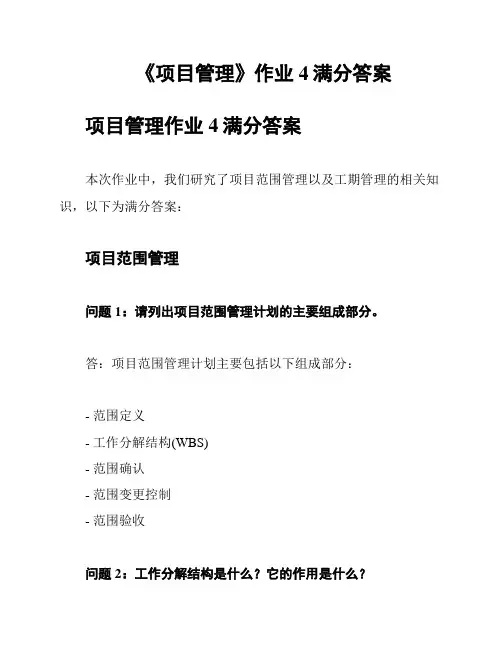
《项目管理》作业4满分答案项目管理作业4满分答案
本次作业中,我们研究了项目范围管理以及工期管理的相关知识,以下为满分答案:
项目范围管理
问题1:请列出项目范围管理计划的主要组成部分。
答:项目范围管理计划主要包括以下组成部分:
- 范围定义
- 工作分解结构(WBS)
- 范围确认
- 范围变更控制
- 范围验收
问题2:工作分解结构是什么?它的作用是什么?
答:工作分解结构(WBS)是将项目划分为不同的阶段和可管理
的组成部分的可视化工具。
它可以帮助项目经理更好地管理项目,
为项目的实施提供指导。
问题3:请解释计划范围管理和控制范围的主要区别。
答:计划范围管理主要是确定如何定义、确认和监控项目范围;而控制范围则是确保范围只能在经过批准的情况下进行变更。
简而
言之,即计划是早期的文档和计划,而控制是项目执行过程中的操作。
工期管理
问题1:请列出工期管理的步骤。
答:工期管理的步骤包括:
- 制定项目时间管理计划
- 定义活动
- 序列活动
- 估算活动资源
- 估算活动持续时间
- 制定进度计划
- 控制进度
问题2:请解释网络图及其作用。
答:网络图是一种可视化工具,用于表示项目活动的关系和依赖关系。
网络图可以帮助项目经理更好地计划时间,并在执行过程中更好地控制进度。
问题3:请列出项目进度管理中使用的工具和技术。
答:项目进度管理中使用的工具和技术包括:
- 网络图
- 决策树分析
- 资源优化技术
- 压缩工期技术
以上是本次作业的满分答案,如有任何疑问,请及时沟通。

EPC工程总承包项目管理方案(工程方案、实施方案)总承包管理方案目录第一章总承包管理总体概述 (4)1.1总承包管理概述 (4)1.2 工程概况 (4)第二章总承包管理与服务目标 (4)2.1总承包管理目标 (4)2.2 总承包服务目标 (6)第三章总承包管理原则 (8)3.1 “公正”原则 (8)3.2“科学”原则 (8)3.3“统一”原则 (8)3.4“控制”原则 (9)3.5“协调”原则 (9)第四章总承包管理模式 (10)第五章总承包管理服务架构 (11)5.1 总承包管理服务组织机构 (11)5.2 组织机构岗位设置 (11)第六章总包与业主、监理、设计、政府部门的配合 (24)6.1 协调好与业主的关系 (24)6.2协调好与设计院的关系 (26)6.3协调好与监理单位的关系 (27)6.4与相关政府部门协调配合 (29)第七章总承包管理方案 (30)7.1 总承包管理的方法 (30)7.2 工程总承包质量管理方案 (31)7.3 工程总承包进度管理方案 (51)7.4 工程总承包施工安全生产管理 (60)7.5 文明施工管理 (72)7.6 施工期间的环境保护方案 (77)7.7工程总承包造价管理实施方案 (84)7.8 工程总承包协调管理 (90)7.9 工程总承包总体服务方案 (94)7.10 工程总承包信息化管理 (101)7.11 工程总承包竣工验收管理 (120)第一章总承包管理总体概述1.1总承包管理概述总承包管理是国际上流行的一种项目管理模式,运用总承包管理模式可以有效的加强项目的整体管理,缩短工期,降低总体项目成本,提高投资效益。
施工总承包管理在时间上涵盖了从建设项目开工至竣工交付使用及保修服务的全过程,在范围上涵盖了参与建设项目施工各方及一切有关的管理活动,实施施工总承包管理既是高质高效完成施工项目的有效手段,也是涉及人、财、物等多种生产要素及服务对象的复杂的管理活动。
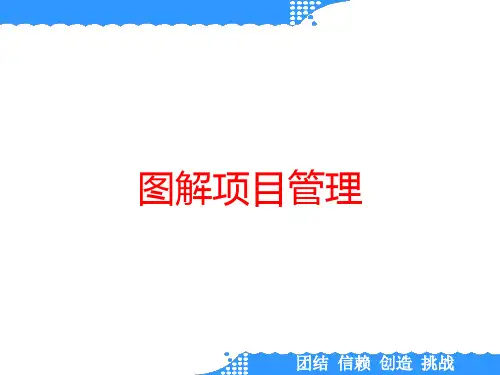
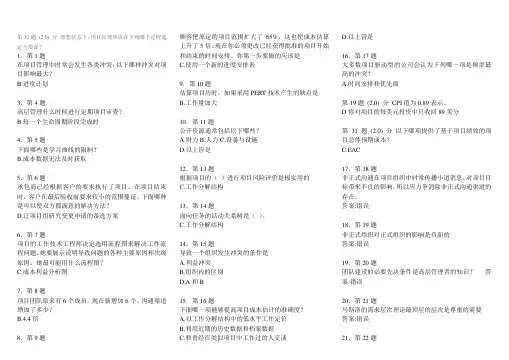
第32题(2.0) 分理想状态下,项目经理应该在下列哪个过程选定与委派?1.第1题在项目管理中时常会发生各类冲突,以下哪种冲突对项目影响最大?B.进度计划3.第4题高层管理什么时候进行定期项目审查?B.每一个生命周期阶段完成时4.第5题下面哪些是学习曲线的限制?B.成本数据无法及时获取5.第6题承包商已经根据客户的要求执行了项目。
在项目结束时,客户在最后验收前要求较小的范围蔓延。
下面哪种是可以使双方都满意的解决方法?D.让项目组研究变更申请的备选方案6.第7题项目的工作技术工程师决定选用流程图来解决工作流程问题。
她要展示说明导致问题的各种主要原因和次级原因。
她最可能用什么流程图?C.成本利益分析图7.第8题项目团队原来有6个成员,现在新增加6个。
沟通渠道增加了多少?B.4.4倍8.第9题顾客把原定的项目范围扩大了65%,这也使成本估算上升了5倍。
现在你必须更改已经获得批准的项目开始和结束的时间安排。
你第一步要做的应该是C.使用一个新的进度安排表9.第10题估算项目历时,如果采用PERT技术产生的缺点是B.工作量加大10.第11题公开资源通常包括以下哪些?A.财力B.人力C.设备与设施D.以上皆是12.第13题根据项目的()进行项目风险评价是极实用的C.工作分解结构13.第14题面向任务的活动关系树是()。
C.工作分解结构14.第15题导致一个组织发生冲突的条件是A.利益冲突B.组织内的区别D.A和B15.第16题下面哪一项能够提高项目成本估计的准确度?A.以工作分解结构中的低水平工作定价B.利用近期的历史数据和档案数据C.和曾经在类似项目中工作过的人交谈D.以上皆是16.第17题大多数项目驱动型的公司会认为下列哪一项是频率最高的冲突?A.时间安排和优先级第19题(2.0) 分CPI值为0.89表示。
D你对项目的每美元投资中只收回89美分第31题(2.0) 分以下哪项提供了基于项目绩效的项目总体预期成本?C.EAC17.第18题非正式沟通在项目组织中时常传播小道消息,对项目目标带来不良的影响。

Writing Good RequirementsAll too often, software requirements are badly written and hard to follow. Clarifying your specifications will benefit everyone involved.by Karl Wiegers. Software Development Magazine, May, 1999It looks like your project is off to a good start. Your team had customers involved in the requirements elicitation stage and you actually wrote a software requirements specification. The specification was big, but the customers signed off on it, so it must have been O.K.Now you’re designing one of the features and you’ve found some problems with the requirements: You can interpret requirement 15 a couple different ways. Requirement 9 states precisely the opposite of requirement 21; which should you believe? Requirement 24 is so vague that you don’t have a clue what it means. You just had an hour-long discussion with two other developers about requirement 30 because all three of you thought it meant something different. And the only customer who can clarify these points won’t return your calls. You’re forced to guess what many of the requirements mean, and you can count on doing a lot of rework if you guess wrong.Many software requirements specifications (SRS) are filled with badly written requirements. Because the quality of any product depends on the quality of its raw materials, poor requirements cannot lead to excellent software. Sadly, few software developers have been educated about how to elicit, analyze, document, and verify requirement q uality. There aren’t many examples of good requirements to learn from, partly because few projects have good ones to share, and partly because few companies are willing to place their product specifications in the public domain.This article describes several characteristics of high-quality software requirement statements and specifications. I will examine someless-than-perfect requirements from these perspectives and take a stab at rewriting them. I’ve also included some general tips on how to write good requirements. Evaluate your project’s requirements against these quality criteria. It may be too late to revise them, but you might learn how to help your team write better requirements next time.Don’t expect to create a SRS in which every requirement e xhibits every desired characteristic. No matter how much you scrub, analyze, review, and refine requirements, they will never be perfect. However, if you keepthese characteristics in mind, you will produce better requirements documents and you will build better products.Characteristics of Quality Requirement StatementsHow can you distinguish good software requirements from problematic ones? Individual requirement statements should exhibit six characteristics. A formal inspection of the SRS by project stakeholders with different perspectives is one way to determine whether or not each requirement has these desired attributes. Another powerful quality technique is writing test cases against the requirements before you cut a single line of code. Test cases crystallize your vision of the product’s behavior as specified in the requirements and can reveal omissions and ambiguities.Characteristic #1: They must be correct. Each requirement must accurately describe the functionality to be delivered. The reference for correctness is the source of the requirement, such as an actual customer or a higher-level system requirements specification. A software requirement that conflicts with a corresponding system requirement is not correct (of course, the system specification could be incorrect, too).Only users can determine whether the user requirements are correct, which is why it’s essential to include actual users, or surrogate users, in requirements inspections. Requirements inspections that do not involve users c an lead to developers saying, “That doesn’t make sense. This is probably what they meant.” This is also known as “guessing.”Characteristic #2: They must be feasible. You must be able to implement each requirement within the known capabilities and limitations of the system and its environment. To avoid infeasible requirements, have a developer work with the requirements analysts or marketing personnel throughout the elicitation process. This developer can provide a reality check on what can and cannot be done technically, and what can be done only at excessive cost or with other trade-offs.Characteristic #3: They must be necessary for the project. Each requirement should document something the customers need or something you need to conform to an external requirement, an external interface, or a standard. You can think of “necessary” as meaning each requirement originated from a source you know has the authority to specify requirements. Trace each requirement back to its origin, such as a use case, system requirement, regulation, or some othervoice-of-the-customer input. If you cannot identify the origin, perhaps the requirement is an example of gold-plating and isn’t really necessary.Characteristic #4: They must be prioritized. Assign an implementation priority to each requirement, feature, or use case to indicate how essential it is to a particular product release. Customers or their surrogates have the lion’s share of the responsibility for establishing priorities. If all the unprioritized requirements are equally important, so is the project manager’s ability to react to new requirements added during development, budget cuts, schedule overruns, or a team member’s departure. You can determine priority by considering the requirement’s value to the customer, the relative implementation cost, and the relative technical risk of implementing it.Many groups use three levels of priority. High priority means you must incorporate the requirement in the next product release. Medium priority means the requirement is necessary but you can defer it to a later release if necessary. Low priority means it would be nice to have, but you might have to drop it because of insufficient time or resources.Characteristic #5: They must be unambiguous.The reader of a requirement statement should draw only one interpretation of it. Also, multiple readers of a requirement should arrive at the same interpretation. Natural language is highly prone to ambiguity. Avoid subjective terms like user-friendly, easy, simple, rapid, efficient, several, state-of-the-art, improved, maximize, and minimize. Write each requirement in succinct, simple, straightforward language of the user domain, not in technical jargon. You can reveal ambiguity through formal requirements specifications inspections, writing test cases from requirements, and creating user scenarios that illustrate the expected behavior of a specific portion of the product.Characteristic #6: They must be verifiable. See whether you can devise tests or use other verification approaches, such as inspection or demonstration, to verify that the product properly implements each requirement. If you can’t verify a requirement, determining whether or not it was correctly implemented is a matter of opinion. Requirements that aren’t consist ent, feasible, or unambiguous are also not verifiable. Any requirement that the product shall “support” something isn’t verifiable.Characteristics of Quality Requirements SpecificationsA complete SRS is more than a long list of functional requirements. It also includes external interface descriptions and nonfunctional requirements, such as quality attributes and performance expectations. Look for the following characteristics of a high-quality SRS.。
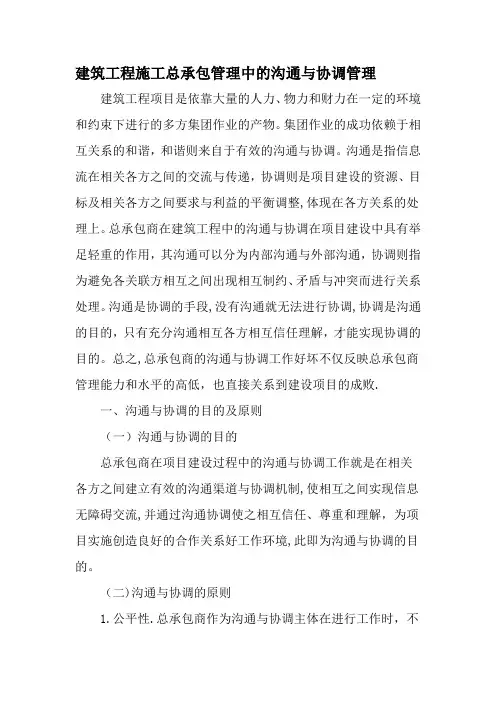
建筑工程施工总承包管理中的沟通与协调管理建筑工程项目是依靠大量的人力、物力和财力在一定的环境和约束下进行的多方集团作业的产物。
集团作业的成功依赖于相互关系的和谐,和谐则来自于有效的沟通与协调。
沟通是指信息流在相关各方之间的交流与传递,协调则是项目建设的资源、目标及相关各方之间要求与利益的平衡调整,体现在各方关系的处理上。
总承包商在建筑工程中的沟通与协调在项目建设中具有举足轻重的作用,其沟通可以分为内部沟通与外部沟通,协调则指为避免各关联方相互之间出现相互制约、矛盾与冲突而进行关系处理。
沟通是协调的手段,没有沟通就无法进行协调,协调是沟通的目的,只有充分沟通相互各方相互信任理解,才能实现协调的目的。
总之,总承包商的沟通与协调工作好坏不仅反映总承包商管理能力和水平的高低,也直接关系到建设项目的成败.一、沟通与协调的目的及原则(一)沟通与协调的目的总承包商在项目建设过程中的沟通与协调工作就是在相关各方之间建立有效的沟通渠道与协调机制,使相互之间实现信息无障碍交流,并通过沟通协调使之相互信任、尊重和理解,为项目实施创造良好的合作关系好工作环境,此即为沟通与协调的目的。
(二)沟通与协调的原则1.公平性.总承包商作为沟通与协调主体在进行工作时,不能以保护自己私立或其中某方的利益为出发点,一味考虑自己的利益与要求,而应该从大局出发,始终以公平为原则,设身处地的为他方着想,站在公平合理的立场开展协调工作。
2。
高效性。
由于大多建筑工程具备工期紧、任务重的特点,施工管理尤其是总承包商的管理工作千头万绪,为了能使各方工作不受影响,其沟通与协调工作的效率性尤为重要。
为了能够实现共作的高效性需要总承包商在必要时采取牺牲自己的蝇头小利来换取对方的信任,从而赢得宝贵时间,以利于工作开展。
3。
真实性。
在沟通与协调工作中信息作为沟通的基础和传达的内容应保证其真实可信,准确可靠.虚假错误的信息不仅会导致对方作出错误的决策判断,且会失信于对方。


西安雅居乐国际花园一期项目部安全管理体系编制人:审核人:审批人:施工单位:中国建筑第七工程局有限公司编制日期:二零一二年六月十五日项目部安全管理体系1 工程概况西安雅居乐国际花园工程包括19#、23#楼和车库,位于西安市长安区。
由西安雅居乐物业投资管理有限公司投资,由陕西省设计研究院有限责任公司设计,由陕西大成监理投资有限责任公司监理,由中建七局承建。
2 安全管理目标安全管理目标:无重大安全(火灾、卫生、机械、交通等)责任事故,死亡率为“0”;轻伤负伤率为≤3‰文明施工管理目标:省级文明工地安全生产保证体系(图附后)..施工现场安全保证体系技术、安全 思想政治工作 群众监督 操作安全项目经理 安全班组活动 安全监督岗安全生产领导小组 现场监控 现场监控 现场监控 现场监控现场监控 安全监督预控班组班前 技术安全交底 作业班组 安全责任制 人的意识与 行为控制 技术措施 劳动保护安全员 责任制 现场保护现场作业3 组织机构认真贯彻执行国家部委有关安全生产和文明施工的规定,结合本公司的要求和该项目的目标,成立以项目经理为首的安全管理组织机构,切实加强施工过程中安全生产的领导,并且配备专职安全员三名,各专业工程均配备兼职安全员,使整个施工现场形成从上到下,专人负责,层层落实的安全生产管理网络。
4 安全管理(一)建立各项安全管理制度 1、分部分项安全技术交底制定《分部(分项)安全技术交底制度》在分部(分项)工程正式施工前,由施工负责人和安全员组织有关管理人员对各班组长及生产工人进行安全技术交底。
使参与施工的人员对施工对象从设计情况、建筑结构的特点、技术要求、施工工艺等方面有一个较为详细的了解,以便科学的组织施工和合理地按排工艺,避免发生技术指导错误和操作错误。
安全技术交底除有口头交底、文字交底外,必要时还可以用图样、实样、现场示范操作等形式进行,同时填写《安全技术交底记录单》并由有关人员签字存档。
需开展对分包单位的安全交底(可结合《总分包单位综合管理交底》进行)。
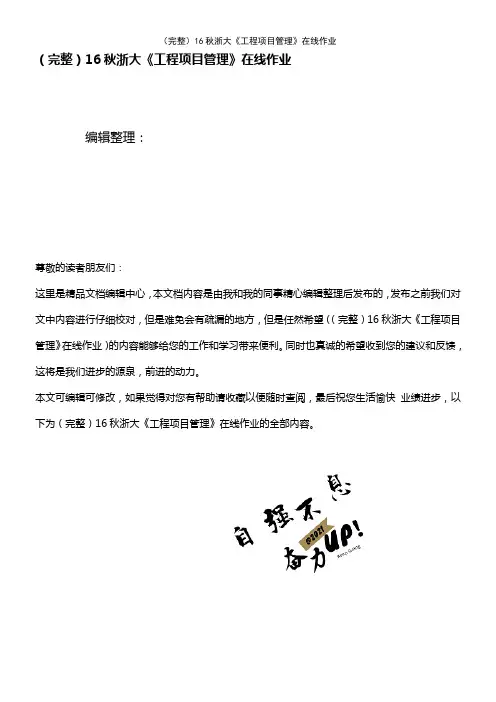
(完整)16秋浙大《工程项目管理》在线作业编辑整理:尊敬的读者朋友们:这里是精品文档编辑中心,本文档内容是由我和我的同事精心编辑整理后发布的,发布之前我们对文中内容进行仔细校对,但是难免会有疏漏的地方,但是任然希望((完整)16秋浙大《工程项目管理》在线作业)的内容能够给您的工作和学习带来便利。
同时也真诚的希望收到您的建议和反馈,这将是我们进步的源泉,前进的动力。
本文可编辑可修改,如果觉得对您有帮助请收藏以便随时查阅,最后祝您生活愉快业绩进步,以下为(完整)16秋浙大《工程项目管理》在线作业的全部内容。
浙江大学17春16秋浙大《工程项目管理》在线作业一、单选题(共 25 道试题,共 50 分。
)1. 根据我国有关法规规定,下列关于招标文件出售的说法正确的是( )。
A. 自招标文件出售之日起至停止出售之日止,最短不得少于20日B。
对招标文件的收费应合理,遵循微利的原则C. 招标人在售出招标文件后,可随时终止招标D。
招标文件售出后,不予退还正确答案:2. 下列为加快进度而采取的各项措施中,属于技术措施的是()A. 编制进度控制工作流程B. 实行班组内部承包制C。
用大模板代替小钢模D. 重视计算机软件的应用正确答案:3。
在你的项目中,你需要将成本分配到发生该成本的期间。
为此,你应该:A. 识别项目各组成部分以分配成本B. 将项目时间表作为成本预算的输入项C。
进行详细和精确的成本估计D。
制定成本绩效计划正确答案:4. .施工成本计划作为施工成本控制的指导文件,其内容包括()。
A。
预定的具体成本目标和实现控制目标的措施B。
预定的具体成本目标和有可能出现的成本偏差C. 预定的经济效益目标和实现经济效益目标的手段D. 可能的工程变更和对变更的控制措施正确答案:5。
下列项目目标控制工作中,属于主动控制的是( ).A。
事前分析可能导致目标偏离的各种影响因素B。
目标出现偏离时采取纠偏措施C. 进行目标的实际值与计划值比较D. 分析目标的实际值与计划值之间存在的偏差的原因正确答案:6。

一、编制依据 (2)二、工程概况与工程实施条件分析 (4)1、工程概述 (4)2、工程设计特点、工程量 (4)3、施工实施条件及自然环境分析 (5)四、工期目标和施工进度计划 (10)1、工期目标及分解 (10)4、进度计划风险分析及控制措施 (13)五、质量管理体系 (14)1、质量目标及分解 (14)2、质量管理组织机构 (14)六、安全管理体系 (22)1、安全目标及分解 (22)2、安全管理组织机构 (24)七、环境保护与文明施工体系 (34)1、施工引起的环保问题及保护措施 (34)八、工地管理和施工平面布置 (37)九、施工方法与资源需求计划 (40)1.1劳动力需求计划 (40)十、施工管理与协调 (54)十一、施工科技创新 (62)十二、主要技术经济指标 (62)1.项目技术经济指标 (63)2、降低成本计划与措施、降低成本计划与措施 (64)一、编制依据为坚持“安全第一、预防为主、综合治理”的方针,认真贯彻国家电网公司建设“一强三优”现代公司目标和“三抓一创”工作思路,确保本工程建设目标的顺利实现。
根据沙坪-柏树林110kV线路工程建设管理规定,施工承包合同,沙坪-柏树林110kV线路工程施工设计图:1.《 110KV~500KV架空电力线路工程施工质量及评定规程》DL/T 5168-20022.《110kV-500kV架空送电线路施工及验收规范》GB 50233-20053.《国家电网公司工程建设质量管理规定》(国家电网基建[2011]1759号);4.《国家电网公司基建安全管理规定》(国家电网基建[2011]1753号)5.《普通混凝土配合比设计规程(JGJ55-2011)》6.《混凝土强度检验评定标准(GB/T 50107-2010 )》7.《混凝土结构工程施工质量验收规范(GB50204-2002 (2011年版))》8.《建筑桩基技术规范(JGJ94-2008)》9.《钢筋焊接及验收规程(JGJ18-2003)》10.《钢结构工程施工质量验收规范(GB50205-2001)》11.《建筑地基基础工程施工质量验收规范(GBJ50202-2002)》12.《建筑工程施工质量验收统一标准(GB50300-2001)》13.《混凝土结构设计规范(GB50010-2010)》14.《钢结构设计规范(GBJ50017-2003)》15.《高压绝缘子瓷件技术条件(GB772-2005)》16.《国家电网公司基建安全管理规定》(川电基建[2011]674号)17.《电力建设安全工作规程(架空电力线路部分)(DL5009.2-2004)》18.《建设工程项目管理规范(GB/T50326-2006)》19.《110kV-750kV架空输电线路设计规范》GB 50545-2010 20.《输变电工程安全文明施工标准》国家电网科(2009)211号21.《国家电网公司输变电工程达标投产考核办法》国家电网基建(2011)146号文22.《四川省电力公司“输变电工程施工安全措施补助费、文明施工措施费”管理实施细则》川电建[2007]431号23.《关于推广应用业主、监理、施工三个项目部标准化工作手册的通知》(国家电网基建 [2010]572号)24.《绿色施工导则》建质[2007]223号25.《输变电工程建设标准强制性条文实施管理规程》(电力工程部分)(2011年版)26.《基建质量通病重点防治计划》川电基建(2012)74号27.《利用数码照片资料加强输变电工程安全质量过程控制》基建安全(2007)25号28.《关于强化输变电工程施工过程质量控制数码照片采集与管理的工作要求》基建质量(2010)322号29. 国家电网公司、四川省电力公司其他有关制度、规定二、工程概况与工程实施条件分析1、工程概述:本工程系沙坪-柏树林110kV线路工程。
第1章项目管理与ProjectProject 2007是继Project 2003之后发布的新一款项目管理工具产品。
它可帮助项目管理人员和工程设计人员有效地管理和规划项目,为用户提供高效和便捷的项目管理方法,易于建立项目日程,更能促进生产力的提高。
本章将详细介绍项目管理基础知识以及Project 2007的功能和基本操作方法。
1.1 项目管理基础许多人在日常生活中都与项目打交道,小到简单的一次约会,大到参加科研开发等。
这些都是有目标的一系列活动。
随着社会的进步、经济的发展,如何提高生产力,如何提高效益已经成为现代经济的热门话题,同时逐渐独立形成一门学科,这就是项目管理。
本节将在使用Project 2007进行项目管理应用前,介绍项目管理中的一些概念以及一些常用技术性词语。
1.1.1 项目概述项目是指在既定的资源和时间约束下,项目成员为实现某种目的而完成一系列相互联系的工作,即为了达到目的而努力展开一系列事件的过程。
同时项目也具有约束性,在指定资源和指定时间的范围内进行,没有这些约束不能称之为项目。
例如,学校组织运动会,目的就是为了提高学生的身体素质;资源包括学生、老师、场地和器材等;时间指某一天或特定时间进行。
为了完成这一目的展开的一系列活动,如培训、锻炼和会场准备等,这就是一个项目。
1.1.2 项目管理概述项目是有目标展开的一系列活动;而项目管理就是指项目的管理者在有限的资源约束下,运用系统的观点、方法和理论,对项目事件进行有效的管理,即对项目的投资立项开始到项目结束的全部过程进行计划、组织、指挥、协调、控制和调度,以达到项目的目标。
项目管理包括的内容如图 1.1所示。
其中的含义如下所示。
项目范围管理:指为了实现项目的目标,对项目的工作内容进行控制的管理过程。
它包括范围的界定、规划和调整等。
项目时间管理:指为了确保项目最终按时完成所实施的一系列管理过程。
它包括具。